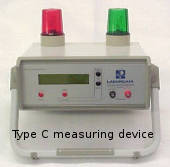|
|
UN Tests of FIBCs
| More than twenty-five years experience in testing FIBCs for dangerous goods in accordance with the UN regulations are a good basis to take a critical view of the tests demanded. It is known that there are six different tests to which an FIBC design type must be submitted. These tests can be divided into two groups. The test requirements of these two groups differ in one important aspect: they differ with regard to the materials used for filling the test samples. The rules state: "The substances to be carried in the FIBCs may be replaced by other substances except where this would invalidate the results of the tests. For solids, when another substance is used it shall have the same physical characteristics (mass, grain size, etc.) as the substance to be carried." This is the theory. In practice these simple and logical sentences cause problems. For the moment I shall discuss the consequences referring to the "mass". The other items (grain size, etc.) will be discussed later. Let us explain the consequences by an example. Assuming a manufacturer asks for an UN approval for SWL = 1500kg (SWL, Safe Working Load is the commonly used term, the UN regulations call it "net mass"), packaging group II, stacking height 4 bags on top of the first one. Let us assume further that he asks for a series of design types (so called FIBC-family) which shall cover FIBCs with base dimensions of 90cm x 90cm and heights of between 90cm and 180cm (i.e. volumes of between 0.800m3 and 1.600m3). For both volumes a net mass of 1500kg can be realised only by using substances of different bulk densities as shown below. Top Lift Test, Stacking Test and Tear Test This first group of tests can be performed easily because these tests require no special bulk density of the filling material. Regardless of the volume of the FIBCs and regardless of the "net mass" the same filling material can be used for these three tests. Normally LDPE granules are used which have a bulk density of round about 550kg/m3 and the grain size of which meets most of the dangerous substances. |
Based on the data of our example the test loads required for this first group of tests are as follows: Top lift test 9000kg (6 x 1500kg) Stacking test 10900kg (4 x 1500kg x 1.8 + 100kg) Tear test 3000kg (compression) and 1500kg (top lift) The weight of LDPE granules filled up to 97% (minimum 95%) of the FIBC heights amounts to 440kg for the short FIBCs and 880kg for the tall FIBCs, repectively. All the necessary test loads mentioned above can be easily charged by a suitable item of test equipment. The weight and the bulk density respectively of the LDPE granules must not be taken into account because the difference missing from the required load is added by the test machines. In other words, the bulk density of the filling material does not influence the test procedure. Drop Test, Topple Test and Righting Test Completely different is the situation in the second group. These tests cause problems because of special requirements regarding the filling material. The FIBCs of this test series must be filled up to minimum 95% of their height (= 95% of their maximum volumes) using a material the weight of which amounts to the net mass (1500kg). In case of filling the FIBCs with LDPE granules only there are missing 1060kg (1500kg - 440kg) in the short FIBCs and 620kg (1500kg - 880kg) in the tall FIBCs in order to reach 1500kg. The short FIBCs need a bulk density of 1875kg / m3 (1500kg / 0.800m3) and the tall FIBCs need a bulk density of 937kg / m3 (1500kg / 1.600m3), i.e. the filling material must have an individual bulk density for each FIBC volume. The calculation shows that the bulk densities of the required substances differ in a wide range. Therefore different substances are necessary for these tests. "Solutions" Of course no laboratory has exactly these substances available. They must be prepared by mixing proper granules. Some labs add gravel or Polystyrol granules to the LDPE granules in order to reach either a heavier or a lighter weight. Dry gravel has a bulk density of round about 1650kg/m3 and Polystyrol granules of round about 40kg/m3. |
In our example the bulk density of gravel is not sufficient to fill SWL = 1500kg into the short FIBCs. The maximum filling weight possible with gravel amounts to 1360kg. Therefore a heavier substance or heavy additives are necessary. The filling substance for the tall FIBCs must be composed of 610kg LDPE granules plus 890kg gravel. Both components need to be mixed accurately in order to be evenly distributed and finally - after the tests are finished - the granules must be separated or the mixture must be stored in the expectation that there will be a future need for them (a lot of silos would otherwise be required for different mixtures!) or alternatively the filling mixture must be thrown away. This procedure is frustrating. The UN regulations suggest a strange way out of this dilemma: "It is permissible to use additives, such as bags of lead shot, to achieve the requisite total package mass, so long as they are placed so that the test results are not affected". If we were to apply this official proposal in our example we should put 120 bags of lead shot, each weighing 10kg, among the LDPE granules of the short FIBCs and 70 bags of lead shot among the LDPE granules of the tall FIBCs. The physical characteristics of such "substances" are far removed from the requirements. Obviously this procedure is not practicable. A manufacturer prepared his samples (SWL 1000kg, 90 x 90 x 150cm) for quality control in another way: he filled 950kg sand (60cm high) into the FIBC and added 50kg wood shavings (90cm) on top of the sand in order to reach the necessary filling height. The wood shavings could be left out because they do not influence the test result. A Hungarian test house (!) has simplified this method precisely in this way. They are using sand only and they do not care about the filling height. A 500kg FIBC (90 x 90 x 110cm) filled with 500kg sand (fill height 33cm, 70% of the FIBC volume remained empty) passed the drop test - of course it did - and was given approval. Until now the Hungarian competent authority has not withdrawn the accreditation of that laboratory. The situation regarding the drop-, topple- and righting tests of FIBCs is really desperate but not hopeless. In my next Comments I shall show practicable solutions and I shall discuss some further items regarding the other UN tests. |
Comments are welcome and these may be sent by letter to Dr Kielbassa, c/o INDUSTRIAL BULK WORLD, 25 West Cottages, Off West End Lane, London NW6 1RJ, UK. Alternatively, he can be contacted direct (tel: +49 531 33 9011, fax: +49 531 33 9013; email: This email address is being protected from spambots. You need JavaScript enabled to view it.).
(64)










